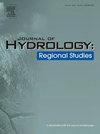海平面和流量对瑞典南部沿海地区河流引发的洪水的复合影响
IF 5
2区 地球科学
Q1 WATER RESOURCES
引用次数: 0
摘要
研究重点沿岸地区由河流引发的洪水是多种驱动因素以复杂方式相互作用的结果。主要的驱动因素是海平面 (SL) 和河流流量 (Q),它们通常表现出一致的行为,需要在洪水风险管理中加以考虑。为了描述和量化 SL 和 Q 对洪水的复合影响,我们开发了一种方法,其中包括利用长时间序列数据进行水力模拟,得出河水水位和洪水淹没面积等输出量的统计特性。进行了优势分析,以量化 SL 和 Q 对河道水位的相对影响。对该地区水文情况的新认识 长期模拟显示,SL 和 Q 对河流水位的相对影响从沿岸到上游变化很大。例如,在 Rönne 河,SL 的影响在距海岸 1 至 11 公里处从 90% 下降到 20%。同时,在相同距离内,Q 值的影响从 10% 增加到 80%。得出的预测水位的简化方程可用于利益相关者预测洪水事件,或用于需要考虑多种备选方案的风险评估。本文章由计算机程序翻译,如有差异,请以英文原文为准。
Compound effects of sea level and flow on river-induced flooding in coastal areas of southern Sweden
Study region
Rönne River, Säve River, and Höje River, Sweden.
Study focus
River-induced flooding in coastal areas results from a multitude of drivers interacting in complex ways. The primary drivers are sea level (SL) and river flow (Q) that often exhibit coherent behavior to be considered in flood risk management. To describe and quantify the compound effects of SL and Q on flooding, a methodology was developed involving hydraulic simulations with long time series of data yielding statistical properties of output quantities such as river water level and flooded areas. Dominance analysis was conducted to quantify the relative influence of SL and Q on river water level along reaches. Also, simplified, empirically based equations were derived to predict the river water level at any location based on SL and Q.
New hydrological insights for the region
The long-term simulations revealed that the relative influence of SL and Q on the river water level changes significantly from the coast to upstream. For example, at the Rönne River, influence of SL decreases from 90 % to 20 % between 1 km and 11 km from the coast. Meanwhile, influence of Q increases from 10 % to 80 % over the same distance. The simplified equations derived to predict the water level can be used by stakeholders to forecast flood events or in risk assessment where many alternatives need to be considered.
求助全文
通过发布文献求助,成功后即可免费获取论文全文。
去求助
来源期刊

Journal of Hydrology-Regional Studies
Earth and Planetary Sciences-Earth and Planetary Sciences (miscellaneous)
CiteScore
6.70
自引率
8.50%
发文量
284
审稿时长
60 days
期刊介绍:
Journal of Hydrology: Regional Studies publishes original research papers enhancing the science of hydrology and aiming at region-specific problems, past and future conditions, analysis, review and solutions. The journal particularly welcomes research papers that deliver new insights into region-specific hydrological processes and responses to changing conditions, as well as contributions that incorporate interdisciplinarity and translational science.
 求助内容:
求助内容: 应助结果提醒方式:
应助结果提醒方式:


